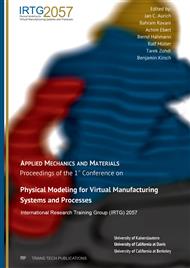[1]
D. Bachmann, F. Weichert, and G. Rinkenauer. Evaluation of the leap motion controller as a new contact-free pointing device. Sensors (Basel, Switzerland), 15(1): 214-233, (2015).
DOI: 10.3390/s150100214
Google Scholar
[2]
M. Baglioni, E. Lecolinet, and Y. Guiard. Jerktilts: Using accelerometers for eight-choice selection on mobile devices. In Proceedings of the 13th International Conference on Multimodal Interfaces, ICMI '11, pages 121-128, New York, NY, USA, 2011. ACM.
DOI: 10.1145/2070481.2070503
Google Scholar
[3]
Ergo Vancouver. Wrist movements, 2017 (accessed February 06, 2017). http: /www. ergovancouver. net/wrist_movements. htm.
Google Scholar
[4]
J. Guna, G. Jakus, M. Pogačnik, S. Tomažič, and J. Sodnik. An analysis of the precision and reliability of the leap motion sensor and its suitability for static and dynamic tracking. Sensors (Switzerland), 14(2): 3702-3720, (2014).
DOI: 10.3390/s140203702
Google Scholar
[5]
G. Jakus, J. Guna, S. Tomažič, and J. Sodnik. Evaluation of leap motion controller with a high precision optical tracking system. Lecture Notes in Computer Science (including subseries Lecture Notes in Artificial Intelligence and Lecture Notes in Bioinformatics), 8511 LNCS(PART 2): 254-263, (2014).
DOI: 10.1007/978-3-319-07230-2_25
Google Scholar
[6]
Leap Motion, Inc. Leapmotion, 2017 (accessed February 06, 2017). https: /www. leapmotion. com.
Google Scholar
[7]
G. Marin, F. Dominio, and P. Zanuttigh. Hand gesture recognition with leap motion and kinect devices. 2014 IEEE International Conference on Image Processing, ICIP 2014, pages 1565- 1569, (2014).
DOI: 10.1109/icip.2014.7025313
Google Scholar
[8]
K. Partridge, S. Chatterjee, V. Sazawal, G. Borriello, and R. Want. Tilttype: Accelerometersupported text entry for very small devices. In Proceedings of the 15th Annual ACM Symposium on User Interface Software and Technology, UIST '02, pages 201-204, New York, NY, USA, 2002. ACM.
DOI: 10.1145/571985.572013
Google Scholar
[9]
L. E. Potter, J. Araullo, and L. Carter. The Leap Motion controller. Proceedings of the 25th Australian Computer-Human Interaction Conference on Augmentation, Application, Innovation, Collaboration - OzCHI '13, (February 2016): 175-178, (2013).
DOI: 10.1145/2541016.2541072
Google Scholar
[10]
M. Rahman, S. Gustafson, P. Irani, and S. Subramanian. Tilt techniques: Investigating the dexterity of wrist-based input. In Proceedings of the SIGCHI Conference on Human Factors in Computing Systems, CHI '09, pages 1943-1952, New York, NY, USA, 2009. ACM.
DOI: 10.1145/1518701.1518997
Google Scholar
[11]
J. Rekimoto. Tilting operations for small screen interfaces. In Proceedings of the 9th Annual ACM Symposium on User Interface Software and Technology, UIST '96, pages 167-168, New York, NY, USA, 1996. ACM.
DOI: 10.1145/237091.237115
Google Scholar
[12]
A. Roudaut, M. Baglioni, and E. Lecolinet. TimeTilt: Using Sensor-Based Gestures to Travel through Multiple Applications on a Mobile Device, pages 830-834. Springer Berlin Heidelberg, Berlin, Heidelberg, (2009).
DOI: 10.1007/978-3-642-03655-2_90
Google Scholar
[13]
J. Ryu, W. P. Cooney, L. J. Askew, K. -N. An, and E. Y. Chao. Functional ranges of motion of the wrist joint. The Journal of Hand Surgery, 16(3): 409 - 419, (1991).
DOI: 10.1016/0363-5023(91)90006-w
Google Scholar
[14]
J. Schwank, F. -A. Rupprecht, and A. Ebert. Waggle - orientation-based tablet interaction. In Proceedings of the 2017 CHI Conference Extended Abstracts on Human Factors in Computing Systems, CHI EA '17, New York, NY, USA, 2017. ACM. to be published.
DOI: 10.1145/3027063.3053151
Google Scholar
[15]
A. Scoditti, R. Blanch, and J. Coutaz. A novel taxonomy for gestural interaction techniques based on accelerometers. In Proceedings of the 16th International Conference on Intelligent User Interfaces, IUI '11, pages 63-72, New York, NY, USA, 2011. ACM.
DOI: 10.1145/1943403.1943414
Google Scholar
[16]
M. C. B. Seixas, J. C. S. Cardoso, and M. T. G. Dias. One Hand or Two Hands? 2D Selection Tasks With the Leap Motion Device. ACHI 2015 : The Eighth International Conference on Advances in Computer-Human Interactions, (c): 33-38, (2015).
Google Scholar
[17]
M. C. B. Seixas, J. C. S. Cardoso, and M. T. G. Dias. The Leap Motion Movement for 2D Pointing Tasks - Characterisation and Comparison to Other Devices. Proceedings of the 5th International Conference on Pervasive and Embedded Computing and Communication Systems, pages 15-24, (2015).
DOI: 10.5220/0005206100150024
Google Scholar
[18]
N. Shariatzadeh, G. Sivard, and D. Chen. Software evaluation criteria for rapid factory layout planning, design and simulation. Procedia CIRP, 3: 299-304, (2012).
DOI: 10.1016/j.procir.2012.07.052
Google Scholar
[19]
J. Shen, Y. Luo, Z. Wu, Y. Tian, and Q. Deng. CUDA-based real-time hand gesture interaction and visualization for CT volume dataset using leap motion. Visual Computer, 32(3): 359-370, (2016).
DOI: 10.1007/s00371-016-1209-0
Google Scholar
[20]
T. Tolio, D. Ceglarek, H. ElMaraghy, A. Fischer, S. Hu, L. Laperrière, S. T. Newman, and J. Váncza. Species-co-evolution of products, processes and production systems. CIRP AnnalsManufacturing Technology, 59(2): 672-693, (2010).
DOI: 10.1016/j.cirp.2010.05.008
Google Scholar
[21]
F. Weichert, D. Bachmann, B. Rudak, and D. Fisseler. Analysis of the accuracy and robustness of the Leap Motion Controller. Sensors (Switzerland), 13(5): 6380-6393, (2013).
DOI: 10.3390/s130506380
Google Scholar
[22]
C. Weidig, P. Galambos, Á. Csapó, P. Zentay, P. Baranyi, J. C. Aurich, B. Hamann, and O. Kreylos. Future internet-based collaboration in factory planning. Acta Polytechnica Hungarica, 11(7), (2014).
DOI: 10.12700/aph.11.07.2014.07.10
Google Scholar
[23]
Wikipedia. Lenticular Lens, 2016 (accessed March 29, 2016). https: /en. wikipedia. org/wiki/ Lenticular_lens.
Google Scholar


